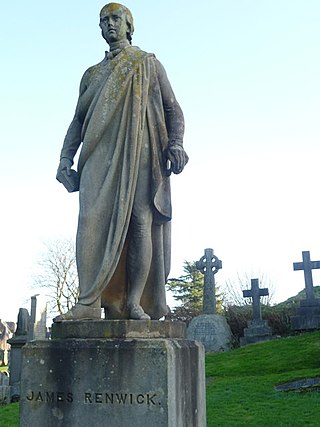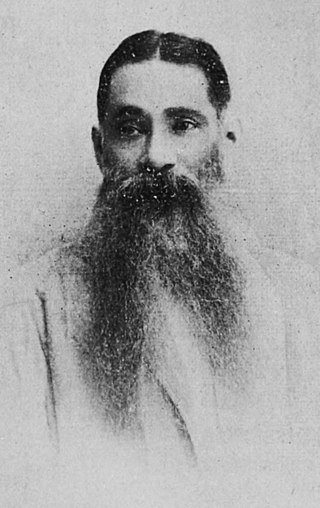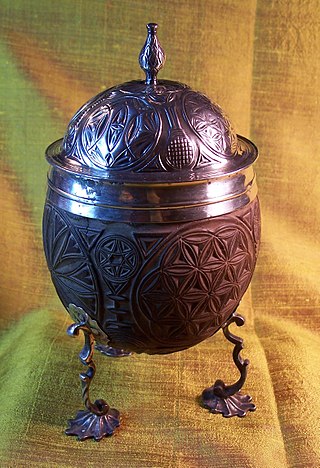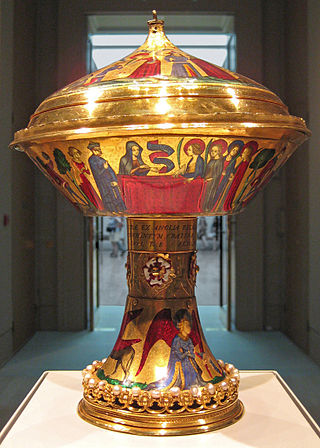

A hanap is an obsolete, Norman-French term for a large drinking goblet, made of precious material such as gold or silver, and used especially on state occasions. [1] [2]


A hanap is an obsolete, Norman-French term for a large drinking goblet, made of precious material such as gold or silver, and used especially on state occasions. [1] [2]
1. Old London Silver, Its History, Its Makers and Its Marks by Montague Howard (1903) "hanap or Standing Cup (1616) Height, 25 inches At St. John's College, Cambridge A radical departure was made in the form of the standing cup of the second ..."
2. Proceedings and Ordinances of the Privy Council of England by Great Britain Privy Council, Harris Nicolas, Great Britain, Nicholas Harris Nicolas, Great Britain Record Commission, England and Wales Privy Council (1834) "Item un autre hanap dargent par tout ... It j. autre hanap dargent playne ove j. tayle entour le ..."
3. Notes and Queries by Martim de Albuquerque (1850) "The hanap frequently occurs in wills and inventories of the thirteenth, fourteenth, and fifteenth centuries. In the will of Lady Clare, 1355*,— "Je devise a ..."

The Judicial Committee of the Privy Council (JCPC) is the highest court of appeal for the Crown Dependencies, the British Overseas Territories, some Commonwealth countries and a few institutions in the United Kingdom. Established on 14 August 1833 to hear appeals formerly heard by the King-in-Council, the Privy Council formerly acted as the court of last resort for the entire British Empire, other than for the United Kingdom itself.

The Privy Council (PC), officially His Majesty's Most Honourable Privy Council, is a formal body of advisers to the sovereign of the United Kingdom. Its membership mainly comprises senior politicians who are current or former members of either the House of Commons or the House of Lords.

His Majesty's High Court of Chivalry is a civil law court in English and Welsh law with jurisdiction over matters of heraldry. The court has been in existence since the fourteenth century; however, it rarely sits. The sole judge is now the hereditary Earl Marshal of England, the Duke of Norfolk, though if not a professional lawyer, he normally appoints a professional lawyer as his lieutenant or surrogate.

The lord president of the Council is the presiding officer of the Privy Council of the United Kingdom and the fourth of the Great Officers of State, ranking below the Lord High Treasurer but above the Lord Keeper of the Privy Seal. The Lord President usually attends and is responsible for chairing the meetings of the Privy Council, presenting business for the approval of the sovereign. In the modern era, the incumbent is by convention always a member of one of the Houses of Parliament, and the office is normally a Cabinet position.
Sir (Nicholas) Harris NicolasGCMG KH was an English antiquary.

The Board of Trade is a British government body concerned with commerce and industry, currently within the Department for International Trade. Its full title is The Lords of the Committee of the Privy Council appointed for the consideration of all matters relating to Trade and Foreign Plantations, but is commonly known as the Board of Trade, and formerly known as the Lords of Trade and Plantations or Lords of Trade, and it has been a committee of the Privy Council of the United Kingdom. The board has gone through several evolutions, beginning with extensive involvement in colonial matters in the 17th century, to powerful regulatory functions in the Victorian Era and early 20th century. It was virtually dormant in the last third of 20th century. In 2017, it was revitalised as an advisory board headed by the International Trade Secretary who has nominally held the title of President of the Board of Trade, and who at present is the only privy counsellor of the board, the other members of the present board filling roles as advisers.

The Killing Time was a period of conflict in Scottish history between the Presbyterian Covenanter movement, based largely in the south west of the country, and the government forces of Kings Charles II and James VII. The period, roughly from 1679 to the Glorious Revolution of 1688, was subsequently called The Killing Time by Robert Wodrow in his The History of the Sufferings of the Church of Scotland from the Restoration to the Revolution, published in 1721–22. It is an important episode in the martyrology of the Church of Scotland.

The Privy Council of England, also known as HisMajesty's Most Honourable Privy Council, was a body of advisers to the sovereign of the Kingdom of England. Its members were often senior members of the House of Lords and the House of Commons, together with leading churchmen, judges, diplomats and military leaders.

Womesh Chunder Bonnerjee was an Indian barrister. He was a co-founder and the first president of Indian National Congress.

The Rugby League World Cup is an international rugby league tournament contested by the top national men's representative teams. The tournament is administered by the International Rugby League and was first held in France in 1954, which was the first World Cup held for any form of rugby football.
Nicola Patricia Smith MBE, née Gardener, is a world champion English bridge player. She has many successes to her credit in more than 30 years of international competition, initially as Nicola Gardener. As of October 2017 she ranked first among Women World Grand Masters both by world masterpoints (MP) that decay annually and by placing points (PP) that do not.
The Clerks of the Signet were English officials who played an intermediate role in the passage of letters patent through the seals. For most of the history of the position, four clerks were in office simultaneously.

A coconut cup is a variety of standing cup, made and used in Western Europe in the 15th and 16th Centuries, with a revival in Georgian England.

The Royal Gold Cup or Saint Agnes Cup is a solid gold covered cup lavishly decorated with enamel and pearls. It was made for the French royal family at the end of the 14th century, and later belonged to several English monarchs before spending nearly 300 years in Spain. It has been in the British Museum since 1892, where it is normally on display in Room 40, and is generally agreed to be the outstanding surviving example of late medieval French plate. It has been described as "the one surviving royal magnificence of the International Gothic age". According to Thomas Hoving, former director of the Metropolitan Museum of Art in New York, "of all the princely jewels and gold that have come down to us, this is the most spectacular—and that includes the great royal treasures."

Stefan von Haschenperg was a military engineer employed by Henry VIII of England in the 1540s.
John Prophet (1356–1416) was an English medieval Secretary to King Henry IV, Keeper of the Privy Seal and, Dean of Hereford and York. A distinguished and capable administrator he remained loyal to all kings through a mix of shrewdness, and cunning. Although guilty of simony and pluralism, Prophet was no lollard, but successfully made the transition from Richard II's extravagant court at Westminster to an indispensable servant of the Lancastrians.

The statue of James II is a bronze sculpture located in the front garden of the National Gallery in Trafalgar Square, London, United Kingdom. Probably inspired by French statues of the same period, it depicts James II of England as a Roman emperor, wearing Roman armour and a laurel wreath. It originally also depicted him holding a baton. It was produced by the workshop of Grinling Gibbons. The execution was most likely, according to contemporary accounts, the work of the Flemish sculptors Peter van Dievoet and Laurens van der Meulen, rather than of Gibbons himself. The statue has been relocated several times since it was first erected in the grounds of the old Palace of Whitehall in 1686, only two years before James II was deposed.
The Great Seal of Ireland was the seal used until 1922 by the Dublin Castle administration to authenticate important state documents in Ireland, in the same manner as the Great Seal of the Realm in England. The Great Seal of Ireland was used from at least the 1220s in the Lordship of Ireland and the ensuing Kingdom of Ireland, and remained in use when the island became part of the United Kingdom of Great Britain and Ireland (1801–1922), just as the Great Seal of Scotland remained in use after the Act of Union 1707. After 1922, the single Great Seal of Ireland was superseded by the separate Great Seal of the Irish Free State and Great Seal of Northern Ireland for the respective jurisdictions created by the partition of Ireland. If the Lord Chancellor was unable for whatever reason to transact business, the Crown might designate another senior judge to act in his place without the Great Seal. In 1375 John Keppock, the Lord Chief Justice of Ireland, was authorised to hear the assizes at Waterford in place of the Chancellor, who was detained on other official business, without the Seal.
Costume and gold and silver plate belonging to Elizabeth I were recorded in several inventories, and other documents including rolls of New Year's Day gifts. Arthur Jefferies Collins published the Jewels and Plate of Queen Elizabeth I: The Inventory of 1574 from manuscripts in 1955. The published inventory describes jewels and silver-plate belonging to Elizabeth with detailed references to other source material. Two inventories of Elizabeth's costume and some of her jewellery were published by Janet Arnold in Queen Elizabeth's Wardrobe Unlocke'd.